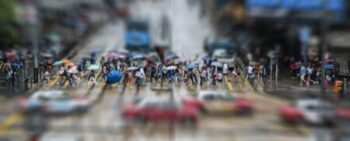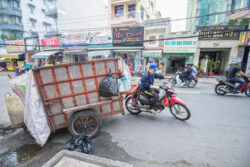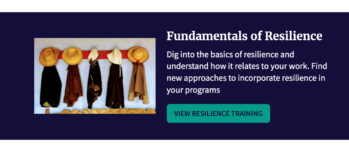With more than half of the world’s population living in cities, and with that number growing each year, it is clear that investing in urban resilience is key to sustainable development, especially in USAID partner countries where most of this rapid urbanization is taking place. Poorer populations in cities are particularly vulnerable to shocks and stressors linked to climate change, pandemics, conflict, income inequality, migration, and other sources. Increasing the capacity of local and national governments and other stakeholders to plan for, mitigate, and adapt to the adverse impacts of disasters and climate change will save lives, reduce losses, and unlock economic and social potential.
Urban resilience programming promotes sustainable, resilient solutions that integrate interventions in water, food security, economic growth, health, social cohesion and protection, education, climate change, disaster risk reduction and resilience, among others.
USAID takes a systems-based, holistic approach to urban resilience that focuses on shocks and stressors related to climate change, geological hazards, urban growth, and other factors. The USAID Urban Resilience Technical Guidance provides a foundation for integration of urban resilience into a variety of USAID programs, including a set of building blocks, illustrative programmatic activities, and other resources. The information below is drawn from the Framework, as well as related USAID and external sources, including the USAID Resilience Policy.
The Urban Resilience Opportunity
Urban resilience efforts can guard against risks and help capture and safeguard benefits of urbanization for residents, especially the most vulnerable. Although the rapid growth of cities benefits billions through greater economic opportunity and access to services, those benefits are not distributed equally and risks, and hazards are also growing.

Urban resilience provides a framework to help cities address today’s problems while embedding a long-term vision that anticipates future risks. Urban resilience approaches enable achievement of a range of development outcomes through a focus on strengthening and better integrating urban systems, which can include communities, infrastructure, the natural environment, cultures, norms, and policies. Urban resilience goes beyond supporting cities in maintaining basic services (i.e., to simply stay afloat); and rather empowers cities to identify and prepare for risks and chronic stressors so that people and systems can more rapidly and equitably recover from disasters, and prepare for future risks.
Read more about resilience on USAID’s ResilienceLinks website and in the Building Resilience to Recurrent Crisis: USAID Policy and Program Guidance.

The USAID Resilience Technical Guidance
The Urban Resilience Technical Guidance provides evidence-based, practical approaches to strengthen urban resilience through USAID programming. Urban resilience programming promotes sustainable, resilient solutions that integrate interventions in water, food security, economic growth, health, social cohesion and protection, education, climate change, disaster risk reduction and resilience, among others.
The USAID Urban Resilience Technical Guidance includes:
– The case for urban resilience and a summary of the global evidence base;
– An overview of approaches USAID can use to advance urban resilience, including a set of building blocks to support integrating urban resilience in programming;
– Key questions to inform the design of interventions, including assessing risks and assets, and identifying opportunities for integration with related programming;
– Selected sector integration guides, providing detailed guidance for integration of urban resilience in governance, health, and power programming.
The framework supports and complements key priorities outlined in the USAID Climate Strategy, Urban Policy, Resilience Policy, Local Capacity Strengthening Policy (currently in draft), Environment and Natural Resources Management (ENRM) Framework, and other related guidance.
WHAT IS URBAN RESILIENCE?
Resilience is a continuous condition rather than a static state, and building resilience is a long-term effort of strengthening systems so they can adapt to current and future circumstances and changes, including responsiveness to evolving citizen needs.

Urban resilience refers to the ability of urban systems to mitigate, adapt to, and recover from shocks and stressors in a manner that reduces chronic vulnerability while positively transforming towards sustainable, equitable, and inclusive development.
Shocks and stressors include those from climate change as well as other sources such as rapid urbanization, pandemics, or conflict. Urban systems include people, communities, infrastructure, the natural environment, and cultures, norms, and policies in cities and towns.
Resilience focuses on strengthening the capacities that help people and systems to:
– absorb shocks by minimizing exposure to them and changing behavior to deal with the impact;
– adapt through measures that identify and manage risks over the longer term;
– transform as the underlying conditions are changed.
Read more about resilience on USAID’s ResilienceLinks website.

How to Strengthen Urban Resilience
USAID can improve development outcomes by strengthening urban resilience, either within stand-alone sectors or by integrated programming across sectors.
Building Blocks
Based on global experience and best practice, USAID has developed the following “building blocks” that can be applied to integrated programming across sectors, as well as to sector-specific programming, to increase the resilience of urban systems:
- Inclusive Planning – Planning for resilience necessitates inclusive, democratic, equitable, evidence-based processes that account for future risk.
- Governance – Strengthening urban governance is central to the effective and inclusive delivery of basic services during and after shocks and stresses.
- Finance – Actions to build resilience often require far more financial resources than city governments can mobilize on their own.
- Social Capital – The networks of relationships and bonds within and across individuals, communities and institutions enable societies to function effectively. Leveraging social capital in the face of stresses and shocks may require identifying relationships that could be strengthened to increase social capital.
- Natural Systems – Restore and protect the natural systems that can contribute to resilience. Natural capital and environmental assets—including open space, forests, biodiversity, and wetlands, both inside and outside of the city’s boundaries— can provide protection from shocks and stresses.
Urban Resilience Resources
USAID Resources
Several key USAID documents and tools related to increasing the resilience of urban systems are listed at right. To search all USAID urban resilience resources click here.

ResilienceLinkss: The USAID Resiliencelinks website includes the Resilience 101 training course and other resources related to resilience and USAID’s work on building resilience in partner countries.
Policy and Program Guidance on Resilience. USAID’s Resilience policy articulates the Agency’s approach to resilience across sectors.
Sustainable Service Delivery in an Increasingly Urbanized World. The USAID Urban Policy considers how urbanization impacts USAID programming across the Agency’s investments.
Local Capacity Development Policy. Strengthening local capacity is a critical component of urban resilience.
Environmental and Natural Resource Management Framework. This framework provides a vision for the integration of environmental and natural resource management across USAID’s sectors.
Visit the Urban Resilience Resources Library for more.
Contacts & Questions
The DDI/EEI Green Cities Division and USAID’s Urban Resilience Working Group are available to support USAID staff who may be looking for additional programming support at either the conceptual/design phase, or during implementation. Please send your questions or request to Monica Bansal, Green Cities Division Lead: mbansal@usaid.gov.

